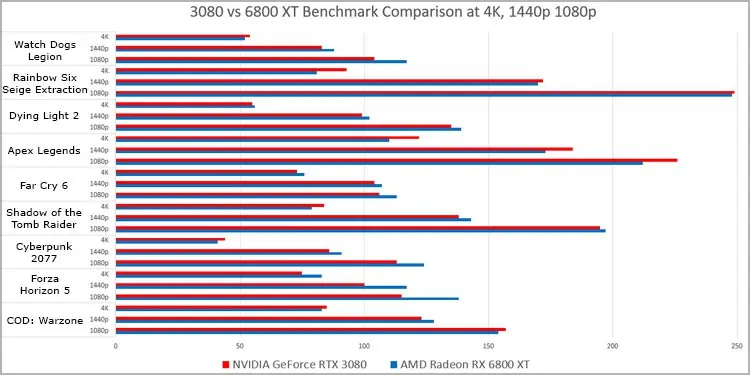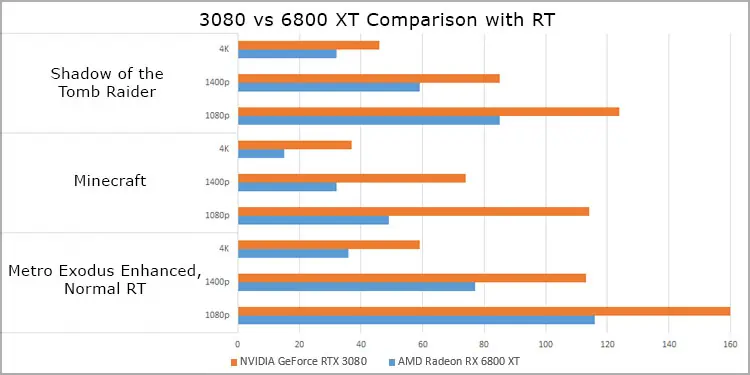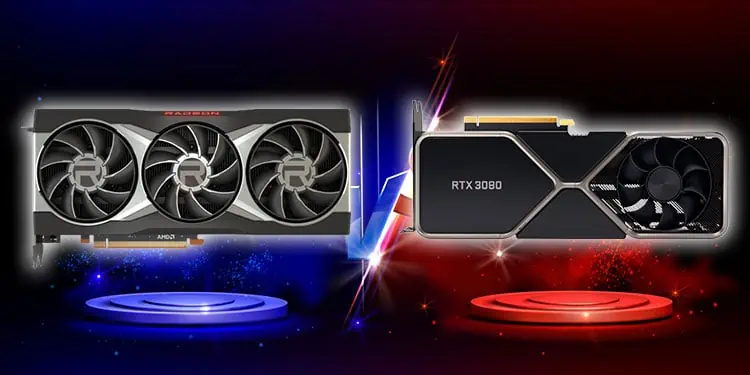Launched on October 28th and September 1st of the year 2020 respectively, AMD Radeon RX 6800 XT and NVIDIA GeForce RTX 3080 are both high-end graphics cards that supports DirectX 12 Ultimate.
This support allows both these devices to allow a realistic gaming experience because of its support for hardware ray tracing, mesh shaders, variable rate shading, and some other technologies.
However, the hardware and base technologies used in both graphics cards are significantly different. So, they do not provide the same performance across all games and other software.
Differences Between 6800 XT and 3080
| Specifications | RX 6800 XT | RTX 3080 |
| GPU Cores | 4,608 Stream processors | 8960/8704 CUDA cores |
| Ray tracing cores | 72 Ray Accelerators | 70/68 Gen 2 RT cores |
| Tensor cores | N/A | 280/272 Gen 3 Tensor cores |
| Base Clock | 1825 MHz | 1260/1440 MHz |
| Boost Clock | 2250 MHz | 1710 MHz |
| Memory | 16GB GDDR6 | 12/10GB GDDR6X |
| Memory Clock | 2000 MHz | 1188 MHz |
| Memory speed | 16GT/s | 19GT/s |
| Memory bus width | 256-bit | 384/320-bit |
| Bandwidth | 512GB/s | 760.3 GB/s |
| Thermal Design Power | 300W | 320W |
| Texture Mapping Unit | 288 | 272 |
| Render Output Pipeline | 128 | 96 |
| Dimension | 26.7x12x5 | 28.5×11.2×4 |
| Outputs | 1x HDMI 2.12x DisplayPort 1.4a1x USB Type-C | 1x HDMI 2.13x DisplayPort 1.4a |
| Power Connector | 2x 8-pin | 1x 12-pin |
Graphics Processing Unit (GPU) Cores
AMD’s Radeon RX 6800 XT has a Navi 21 variant GPU that uses the RDNA 2 architecture. In contrast to that, NVIDIA’s GeForce RTX 3080 uses the GA102 variant GPU with Ampere architecture.
Going into the differences between these GPUs will take a whole article. But the main thing is that Navi 21 has 5120 total cores or shaders and GA102 has 10752 total cores. AMD and NVIDIA both disabled some of the processing cores on these GPUs to reach the target number of 4,608 Stream processors and 8704 CUDA cores on 6800 XT and 3080 respectively. In the 12 GB version of 3080, NVIDIA enabled an additional amount of 256 cores, increasing the total count to 8960.
Now, while 3080 has an overwhelmingly high number of shaders, it does not directly correlate to performance. In GA102, half the number of CUDA cores are dedicated Single-precision Floating point (FP32) processors and the rest can work as either FP32 or Integer (INT32) processors. The Ampere architecture of GA102 also takes two cycles to resolve an instruction set or a thread group. In Navi21, however, all cores can be either FP32 or INT32 processors and RDNA 2 only takes one cycle to complete a thread group.
So, the main takeaway is that you can’t really use the difference in shaders to compare the two graphics cards. The points you actually need to analyze are some other specifications and benchmark tests that reflect real-world cases.
Clock and SGRAM/Memory
You don’t really need to consider the clock that much. In real use, the clock speed you’ll get will be different than both the base clock and the boost clock. Also, the clock only indicates the speed of one single instruction cycle. Each complete render takes a bunch of such instruction cycles and depends on other factors, such as bus width as well.
So, what you need to consider is the difference in the memory or SGRAM’s capacity and speed.
6800 XT provides 16 GB of SGRAM memory which is significant considering the 10 GB that the previous versions of 3080 used to provide. Now that, 12 GB models are also available, the difference is not that consequential. For most games, you won’t run into bottlenecks due to having this 4GB less memory. And for games where you do, both these graphics cards are not sufficient, so you’ll want to use higher-spec hardware anyway.
The GDDR6X SGRAM on 3080 provides a much higher transfer rate compared to GDDR6 on 6800 XT and you’ll experience fewer stutters and lags. With enough capacity, you’ll experience more smooth performance with GDDR6X.
For more information on the difference between these SGRAMs, we recommend checking out our article on GDDR6 vs GDDR6X.
Base Frame Rates
After benchmarking several games with the same settings, we found varying results across the board.
We used an AMD Ryzen 9 CPU as you’ll get lower results for AMD GPUs on Intel CPUs. NVIDIA performs the same regardless of the CPU manufacturer so there’s no problem. We also had 32 GB DDR4 3200MHz RAM on dual-channel.
We set the games to the highest graphic settings and tested for the average FPS on 1080p, 1440p, and 4K resolutions. We disabled Ray Tracing as most games don’t support this feature yet and used the latest graphics drivers available at the time.

While there was no unanimous winner, we could draw a conclusion by analyzing the performance of most games.
- NVIDIA RTX 3080 provides much better performance for most games at 4K. Even in some games where AMD shows more frame rates, the difference is not that high.
- At 1440p, the difference is not that significant. But for the most part, NVIDIA still performs slightly better. You’ll usually get 100+ FPS with both devices so the difference may not matter.
- At 1080p, we observed that AMD performed slightly better than NVIDIA for the majority of the sample games. But the difference is still not that significant considering both perform on an average of 120 FPS.
We can’t say that we tested on an extremely high number of games. However, we still benchmarked 50+ popular games to come to this conclusion. But as the results differ greatly among the games, we still recommend you to check the benchmark for your own
Ray Tracing (RT)
Ray Tracing technology provides a real-life light effect on shadows and reflections. When we consider this technology, NVIDIA performs remarkably better than AMD.
While AMD 6800 XT includes 72 Ray accelerator cores, which is slightly more than the 70 or 68 RT cores on NVIDIA RTX 3080, these generation 2 cores on NVIDIA provide much better performance.
If you benchmark games with Ray Tracing at the highest setting, you’ll experience extremely low frame rates with 6800 XT, especially on 4K. With RTX 3800, the frame rates will still be lower than average, but not as low as 6800 XT.

While the difference is not that significant after enabling RT for 1440p or 1080p, lowing shadow/reflection, and enabling DLSS/FSR 2.0 upscaling, the difference is not that significant. However, lowering your resolution to enable Ray Tracing does not seem like a good trade-off.
Also, if the games you usually play have very high-quality shadows and reflection textures, the game may be unplayable with 4K RT. You will similarly need to use upscaling with lower resolutions even for NVIDIA, which doesn’t look as good as regular 4K. So, since you are not likely to use ray tracing in such a scenario, you might find 6800 more suitable.
Upscaling – FSR 2.0 vs DLSS
Another parameter you need to consider is the upscaling technology used in these graphics cards. Higher resolutions like 4K drastically drop the FPS. In such cases, you can set a lower resolution like 1080p while upscaling to a higher resolution to get a similar effect but without the drop in performance.
The quality will not be fully on par with the regular high resolution and you may get smudged renders or uneven blends on textures. However, with better upscaling technology, you won’t notice many inconsistencies unless you try being nitpicky.
NVIDIA’s Deep Learning Super Sampling (DLSS) has a marked advantage over AMD’s FidelityFX Super Resolution 2 (FSR 2.0). So the upscaled graphics on 3080 looks much better than that on 6800 XT. But if you don’t compare them side by side the 6800 XT renders will still look pretty good if your base resolution is 1440p or higher.
Since the upscale algorithm needs more work to produce quality work with lower base resolutions, such as 1080, here you’ll see stark differences in the images rendered by the two graphics cards.
FSR 2.0 is also a newer technology than DLSS so there are fewer games that support it. You can mod in the support for FSR but that’s too much work to enable it in just one game.
Smart Access Memory vs Resizable BAR
Resizable BAR (Base Address Register) is an optional PCIe technology on Intel CPUs. It helps improve game performance in some games by transferring assets as requested by the GPU according to the BAR size instead of individual textures or shaders multiple times.
Since this technology only improves performance for some games and decreases it for others, NVIDIA has created a list of applications where this technology applies. So, when you enable it on your settings, the feature only applies to those games.
The Smart Access Memory (SAM) is AMD’s proprietary BAR. It is a similar technology with the main difference that, if enabled on your system, it applies to all games. Also, AMD GPUs only allow using the SAM technology, not Resizable BAR. It is also one of the main reasons why AMD GPUs work way better with AMD CPUs.
Certain games, such as Forza Horizon 5, show improved performance with SAM or Resizable BAR. However, if NVIDIA has not enlisted it, you need to manually use third-party apps like NVIDIA Profile Inspector to enable it on the game. So, it will show high performance with 6800 XT if you enable SAM. If you often play similar games on your computer, this graphics card is more suitable for your use.
Monitor Support
NVIDIA and AMD both have their own proprietary adaptive sync technology, FreeSync, and G-Sync to prevent screen tearing. And both technologies need separate dedicated chips inside the Monitor.
Contrary to AMD GPU, which only supports FreeSync, NVIDIA works great with both G-Sync and FreeSync. Also, FreeSync provides lower input lags while G-Sync is better at resolving screen tearing. So, depending on your need or the technology in the monitors you already have, you might prefer AMD RX 6800 XT or NVIDIA RTX 3080.
Apart from these, you should also note that the 6800 XT also includes a USB-C monitor port, which RTX 3080 lacks.
Live Streaming
If you want to stream your games, you need a good GPU encoder. NVIDIA RTX 3080’s NVENC encoder has a crushing advantage over AMD 6800 XT’s encoder in this regard. NVENC provides better quality and smooth streaming at lower data rates.
Power Consumption
The Thermal Design Power (TDP) for RX 6800 XT is 300W and that for RTX 3080 is 320W. While the power consumption in real-time depends on other factors as well, RTX 3080 is definitely more power-hungry than its counterpart.
AMD’s RDNA 2 cards are more efficient than NVIDIA’s Ampere ones so you can get higher clocks and transistor density with more efficient power usage.
The temperature on both cards does not rise much though. This is in part due to the fantastic cooling systems but the case still stands. So, you’ll not get thermal throttling issues unless you overclock these GPUs.
Cost
As of the time of this article, the Manufacturer Suggested Retail Price (MSRP) of AMD 6800 XT stands at 650$ and that of NVIDIA 3070 is 800$ for the 12 GB one and 700$ for the 10 GB one. While the actual prices fluctuate widely depending on customization by motherboard companies, the AMD GPU should be somewhat cheaper.
Which One is Better?
The above comparisons might have given you a better idea of the pros and cons of the graphics card. So, you may already be leaning toward one of the two depending on your situation.
To summarize, if you don’t need Ray Tracing and play varieties of games at 1080p or 1440p, you might prefer 6800 XT because of its cheaper price and more than enough performance.
However, if you are a 4K gamer and Ray Tracing is important to you, the NVIDIA GPU is obviously the best choice. It is also a good choice for 4K gaming as it has DLSS as the better upscaling technology.
That said, if you value performance more than appearance, as E-Sports players or professional app users do, you need to look at the relevant benchmarking instead.
Finally, also make sure that your CPU or RAM does not bottleneck the GPU as your gaming performance will drastically suffer in such scenarios.
